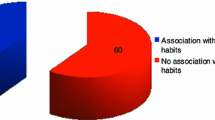Abstract
Several dietary and lifestyle habits can be associated with headaches or with their progression to chronic forms in adults. We report the results of the first population study performed in Italy on a sample of preadolescent and adolescent students to assess the possible association between headache and specific habits and lifestyle factors. Preliminary data from 800 questionnaires showed that 365 subjects had headaches, which were of moderate–severe intensity, associated with anorexia, and caused absence from school in more than 50 % of students. The main finding was the evidence of a clear association between headache and irregular intake of meals (especially irregular breakfast) and sleep disturbance with significant differences when subjects with and without headache were compared. If confirmed, these results are likely to influence clinical practice as well to address educational programs in preadolescents and adolescents.
Similar content being viewed by others
References
Lu SR, Fuh JL, Juang KD, Wang SJ (2000) Migraine prevalence in adolescents aged 13–15: a student population-based study in Taiwan. Cephalalgia 20:479–485
Abu-Arafeh I et al (2010) Prevalence of headache and migraine in children and adolescents: a systematic review of population-based studies. Dev Med Child Neurol 52:1088–1097
Kröner-Herwig B, Heinrich M, Morris L (2007) Headache in German children and adolescents: a population-based epidemiological study. Cephalalgia 27:519–527
Zwart JA, Dyb G, Holmen TL, Stovner LJ, Sand T (2004) The prevalence of migraine and tension-type headache among adolescents in Norway. The Nord-Trøndelag Health Study (Head-HUNT-Youth), a large population-based epidemiological study. Cephalalgia 24:373–379
Seshia SS (2012) Chronic daily headache in children and adolescents. Curr Pain Headache Rep 16:60–72
Bigal ME, Lipton RB (2006) Modifiable risk factors for migraine progression. Headache 46:1334–1343
Molarius A, Tegelberg A, Őhrvik J (2008) Socio-economic factors, lifestyle and headache disorders—a population-based study in Sweden. Headache 48:1426–1437
Kelman L (2007) The triggers or precipitants of the acute migraine attack. Cephalalgia 27:394–402
Panconesi A (2008) Alcohol and migraine: trigger factor, consumption, mechanisms. A review. J Headache Pain 9:19–27
Milde-Busch A, Blaschek A, Borgrafe I, Heinen F, Straube A, von Kries R (2010) Associations of diet and lifestyle with headache in high-school students: results from a cross-sectional study. Headache 50:1104–1114
Ghandour RM, Overpeck MD, Huang ZJ, Kogan MD, Scheidt PC (2004) Headache, stomachache, backache, and morning fatigue among adolescent girl in the United State: associations with behavioral, socio-demographic, and environmental factors. Arch Pediatr Adolesc Med 158:797–803
Kujala UM, Taimela S, Viljanen T (1999) Leisure physical activity and various pain symptoms among adolescents. Br J Sports Med 33:325–328
Järvelaid M (2004) Adolescent tobacco smoking and associated psychosocial health risk factors. Scand J Prim Health Care 22:50–53
Waldie KE, McGee R, Reeder AI, Poulton R (2008) Associations between frequent headaches, persistent smoking, and attempt to quit. Headache 48:545–552
Acknowledgments
The authors thank all students and teachers for their time and efforts: IC Benedetto Croce, Lauro (AV); Istituto Superiore Lorenzo Lotto G.B Rubini, Bergamo; Istituto Edmondo de Amicis, Milano; Istituto Tecnico Statale Commerciale E. Fermi, Vittoria (RG); Liceo Classico D.A. Azuni, Sassari. We also thank Stefania Mancini for her kind support.
Conflict of interest
This study was promoted and funded by Fondazione Italiana Cefalee onlus (FICEF). One of the authors (P. Messina) received a grant for FICEF.
Author information
Authors and Affiliations
Corresponding author
Rights and permissions
About this article
Cite this article
Moschiano, F., Messina, P., D’Amico, D. et al. Headache, eating and sleeping behaviors and lifestyle factors in preadolescents and adolescents: preliminary results from an Italian population study. Neurol Sci 33 (Suppl 1), 87–90 (2012). https://doi.org/10.1007/s10072-012-1048-3
Published:
Issue Date:
DOI: https://doi.org/10.1007/s10072-012-1048-3




